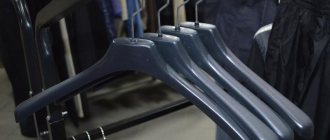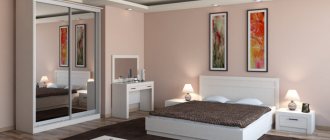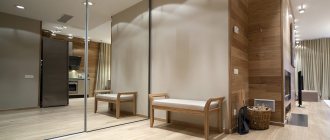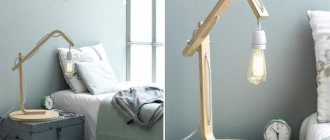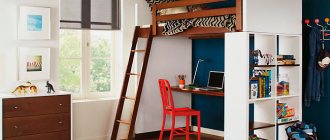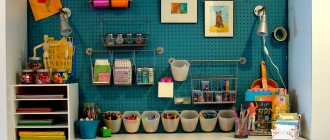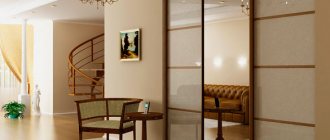Metal hangers
Strong, lightweight and durable. They are not deformed, but a lot depends on the metal from which they are made. They are usually made of steel and aluminum. You should not hang heavy jackets and coats on aluminum ones.
Advice: It’s better to get rid of cheap wire models. They do not support weight, and besides, they can get dirty, leave snags, and electrify the item.
It is more practical to buy hangers made of rubberized metal, but it can be difficult to wash (the top layer of braid becomes covered with pellets), and this is not entirely useful for clothes.
Material of manufacture
The choice of material for any item will always determine its strength and service life. Hangers are no exception. Today, manufacturers offer models made from the following materials:
- Metal – the most durable option with many design options and a wide range of colors. Metal hangers, depending on their appearance, can complement and harmoniously highlight any interior. Forged hangers in hallways look especially luxurious and expensive.
Of course, such an element must be consistent with the style of the room. Metal models have an impressive weight, which is why they require reliable fastening. Floor-standing models are particularly durable and elegant. Steel structures can withstand even heavy winter clothing without the risk of deformation. Lighter aluminum hangers are used for demi-season clothing and storing small items. The most popular are chrome, black, white or dark brown metal hangers. However, the powder coating method allows you to choose any color. This coating will reliably protect the surface from corrosion. - Tree It has always been and remains a popular material for the manufacture of many pieces of furniture. Its strength, durability and natural beauty are still highly valued by consumers. Thanks to the pliability of this material, it is possible to decorate the surface of a wooden hanger with artistic carvings. The tree is absolutely safe even for the smallest family members. Very important, so that the surface of the product has a layer of protective coating in the form of varnish and is polished. Roughly processed wood will have burrs that can ruin clothing or delicate scarves. The most suitable wood species are beech, pine, oak, and birch. You should not hang wet clothes or umbrellas on wooden hangers in the hallway if there is no water-repellent impregnation. Wood can quickly absorb moisture, which will lead to deformation and subsequent cracking after drying.
- Rattan - a modern material that is gaining increasing popularity. It is a type of wood, but is lighter in weight. At the same time, strength indicators remain at a high level. There is also artificial rattan, which looks very attractive. Rattan hangers will look unusual and original and will ideally complement the interior of a hallway in an oriental style.
- Plastic is a leader in the variety of shapes and colors. Often, it is from this material that many designers create their masterpieces. Essential disadvantage plastic hangers is their low strength. This option is suitable for children's or light spring clothing, scarves, hats, umbrellas and handbags.
- Chipboard or MDF – the most common materials for the manufacture of cabinet and other furniture at an affordable price. They are much cheaper than natural wooden models. Do not forget that chipboards contain resins, which can emit harmful substances. Take products where formaldehyde emissions are at the E0 or E1 level. It is better to give preference to models made of MDF, which are safer, but also more expensive. In addition, MDF is moisture resistant and very durable. The best option there will be placement of metal hooks on the canvas. An MDF hanger is not too heavy, but can withstand any load.
- Combined models are, for example, a wooden base combined with glass shelves and metal hooks. Or a combination of metal and plastic. Sometimes others use natural materials – driftwood of bizarre shapes, which are impregnated with special solutions that prevent rotting and protect from moisture. Such elements can be attached to the wall using leather straps or metal rings. These compositions look very impressive.
Wooden hangers
They are made from hardwood. The most expensive, but durable. Easily withstands outerwear. When choosing such hangers, you need to pay attention to the quality of polishing and metal of the hook-holder.
They must be smooth and varnished, otherwise it is easy to damage clothing or splinter your hand.
Classic, made of relatively thick slats, with a crossbar and a strong hook - just the thing for outerwear. Thin ones without a crossbar are suitable for second-layer clothing (if optimally smooth). An important advantage is that they remove static electricity from the fabric.
What clothes are suitable for hangers?
First, think about what clothes should be on the hangers? First of all, one that wrinkles or can become deformed if stored folded on shelves. These are, of course, shirts, jackets, dresses, coats and skirts.
Interestingly, hanging sweaters on hangers is a common mistake. This, unfortunately, can lead to premature aging of your items. You should be aware that fibers can stretch under the influence of their own weight. This, in turn, will cause sweaters to become shapeless and look bad. So if you want to take care of your wardrobe, fold your sweaters and place them on shelves.
Additional properties
Many models have a crossbar or two clothespins along the edges. It is better to hang skirts on clothespins, and a crossbar is more suitable for trousers. The rounder and thicker it is, the better; a thin crossbar will leave a crease in the fabric.
Hangers for scarves, ties, etc. - there are others. They have a second hook, under the main holder. Or rings on the crossbar. Or they are shaped like half a chamomile. It is most convenient to hang accessories on rings and loops.
Ideal hangers for everything:
- non-slip,
- relatively wide, but not massive,
- with crossbar,
- for blouses - the same width as the back of the product, for trousers - such a width so that the product does not gather like an accordion,
- with rotating hook holder,
- with hooks at the bottom for loop holders on skirts.
Design and shape of the hanger
Once you have decided exactly where the hanger will be located, it’s time to decide on two more very important parameters. The design of this piece of furniture comes in two types:
- One-piece
- Collapsible
In the first case, you get a monolithic structure that cannot be disassembled and hidden when not needed. But such models are more reliable and stable.
In the second case, you get a model consisting of several basic elements. Such hangers are more compact and mobile, saving space. At any time they can be easily dismantled and moved to another location. However, they are less reliable and can withstand less load. Weak points are the places where elements are connected to each other, which can become loose or collapse if not used properly. When giving preference to collapsible structures, be sure to ensure that they come with assembly instructions.
also plays an important role . Not only capacity, but also visual appeal and ergonomics depend on it. Considering the size of your hallway and the space allocated for placing the hanger, choose the most harmonious model:
- Linear horizontal or vertical. The most common form. The number of things it can fit is directly proportional to its length or height. Horizontal hangers are usually wall, over-door or ceiling hangers. Floor models or models made in the form of pencil cases with several levels of hooks have a vertical way of arranging things. On the lower tiers it is convenient to place children's clothing, which is not very long.
- Corner hanger will become indispensable in cramped conditions. It is absolutely in no way inferior in capacity to linear models, but it helps to rationally use space or fill an empty corner. Such models are often equipped with shelves for shoes and hats.
- Non-standard solutions It is appropriate to use when the issue of storing things is not as pressing as the issue of giving the room a characteristic shade. Such models can have the most varied and intricate forms: repeat the appearance of real tree branches, branched deer antlers, be multi-level and resemble sea waves. Designers have succeeded in this matter. These hangers are usually used to store keys, umbrellas or small handbags. They serve as interior decoration, while at the same time giving it a more homely feel. It cannot be said that absolutely all hangers of non-standard shapes are not spacious and cannot withstand heavy loads. Therefore, you should not immediately abandon such models.
In addition to the variety of shapes and designs, you have to decide whether your hanger will have an open, closed or combined type:
- Open models are very popular, fit harmoniously into many interiors and look less bulky.
- Closed structures equipped with doors look more strict . But they prevent dust from settling on your things. In addition, they are neater and make the hallway more neat and harmonious.
- Combined designs can have an open row with hooks or hangers for outerwear and side or floor cabinets with doors for storing shoes and other items.
It is not always possible to find the desired hanger option among those offered by manufacturers. In this case, you can seek help from specialists who will make a model according to your sketch. Its cost may be slightly higher, but it will fit perfectly into the interior and will meet all your requirements.
Standard sizes
| Purpose, who is suitable | Width, cm |
| Children's | 25 |
| For petite girls with sizes 38-42, or XS | 39—41 |
| Clothing size 46-50 | 41—43 (metal hangers), 45 (wooden) |
| For L sizes | 43 |
| XXL | 46 |
| Men with clothing sizes 44-46 | 43 |
| For size L (48-50) | 46 |
You can also find hangers with a width of 55 cm - you just need to look.
Stylistic features of choice
Considering that a clothes hanger in the hallway will not go unnoticed, it is necessary that it complements and does not contradict the style of the room. Let's consider the characteristic features of the most popular styles in recent times:
- An elegant forged hanger will harmoniously fit into a Baroque style interior . Moreover, some of its surfaces can additionally be finished with gold-plated powder;
- A classic setting would not be complete without a wooden wall hanger of a strict shape or a floor option decorated with carvings;
- In a room decorated in a rustic style, hangers made from natural materials would be appropriate. An ideal option would be a wall hanger made from a tree branch with knots;
- Provence style implies the presence of a delicate floral pattern, which may be present on the surface of a wooden or metal hanger;
- Style modern clearly stands out with its bizarre, curved shapes. The most suitable material for it would be metal or plastic;
- High-tech and minimal are distinguished by simple, laconic forms without any fancy curls. This can be a flat wooden plank or metal hooks of rectilinear shapes;
- Style loft can’t do without chrome or black metal surfaces. A hanger in this style is always simple, straightforward and as comfortable as possible.
DIY hanger
You can make soft hangers for delicate fabrics yourself. As a basis - scraps of a plastic pipe of small diameter. You will also need:
- foam rubber or synthetic winterizer;
- double sided tape;
- fabric for covering;
- hook (buy ready-made or twist from thick wire).
How to assemble:
- A hook is embedded in the middle of the tube.
- Then the soft padding is attached using double-sided tape.
- Rectangular covers are sewn from finishing fabric along the length of the pipe (with a small margin), which are stretched on both sides and connected with a hidden seam under the hook, covering all protruding parts.
Strictly speaking, there is no perfect hanger. Each type of clothing and size has its own model. Wooden - for a fur coat, thin plastic - for clothes of the second layer, durable metal ones in silicone or rubber braiding - for clothes of the second layer and light outerwear, from windbreakers to coats.
Types of hangers depending on location
Before purchasing this necessary item, you should decide where exactly you want to place it, and to what extent functional it should be. The first parameter directly depends on the size of the room. If you are lucky enough to have a spacious hallway, then there are no restrictions for you. You can choose any model you like. For small and narrow hallways
it is preferable to choose more compact placement methods so that the hanger does not take up much space and does not interfere with free movement along the corridor.
The presence or absence of a wardrobe in the hallway plays an important role. It, like a hanger, has the function of storing things. However, in its absence, the load on the hanger will increase. In this case, the over-the-door structure may simply not accommodate the required volumes, and the ceiling model may not even be able to withstand the excess weight. A correct assessment of the future load of this piece of furniture will be the determining factor that will help you choose the optimal type. Fortunately, modern manufacturers offer so many different versions of this common item that difficulties should not arise.
Wall hangers for clothes in the hallway
These are one of the most popular hangers today. They are individual hooks that can be arranged in any way - diagonally, staggered or linear. Or a panel with hooks, which in turn is attached to the wall. This hanger is very compact, allows you to fit a sufficient amount of outerwear, does not take up space on the floor and is inexpensive. This is one of the most successful options for modest-sized hallways. Some models can be additionally equipped with:
- Mirror;
- Hanging rods, which makes storing clothes more delicate and careful;
- Shelves for storing hats or small items;
- A place to store umbrellas;
- Shoe cabinet;
- A bench with a shoe cabinet underneath.
The last two options can be either solid (in the form of a dressing table) or unrelated elements. In any case, they will be larger and require much more space for placement. In addition, models with floor stands cannot always fit a full-length coat or fur coat.
A little advice: it is better to give preference to hangers in the form of panels, on which hooks are attached and which have a back wall. This will protect the wall covering on which it will be attached from dirt, premature erasing (in the case of wallpaper) and getting wet from wet clothes.
Floor hanger in the hallway
Its design is a rack with hooks at different heights or a rack with vertical or horizontal crossbars. The variety of design options for floor-standing models is amazing. From the simplest ones, which are often found in small coffee shops, to real works of art that become the highlight of the entire room. The advantage in this case is:
- No installation and mobility. It is enough to assemble the floor hanger, if it is not solid, place it in the desired place and use it. If necessary, it can be easily rearranged. In some cases, special wheels are even provided for this;
- This design allows you to hang long items at their full length and maintain their neat appearance;
- The upper part of the hanger is used to place hats, which does not require additional shelves and preserves the aesthetic appearance of the model.
The disadvantages include:
- Bulky. Since things are arranged in a circle, the hanger should be at a sufficient distance from the walls to ensure ease of use. In this case, it will occupy a decent area, which is a completely unsuitable option for small hallways;
- Instability. If the load is uneven, there is a risk of tipping over;
- Difficult access to things. In many models, the hooks are arranged in a double row - a small hook on top and a slightly larger one below it. To remove something that is on the bottom tier, you will have to remove the top one as well. And if the hanger is fully loaded, then more than one. Therefore, this option is not very convenient if you always have a lot of guests in your house or if there are a lot of people living in your house.
Many floor racks are additionally equipped with a lower shelf for bags, hooks or baskets for umbrellas, or even a small cabinet for shoes. Another type of floor hanger is a model made in the form of a small pencil case with or without a mirror. In this case, it will be more convenient to use and stable, but it will not be able to be easily moved.
A little advice: if you decide to purchase a structure with horizontal crossbars, be sure to place hangers with hangers on them. This technique will not only help you fit more things, but will also keep their style from being pulled out. Before purchasing, pay attention to the number of support legs. Models with more of them will always be more stable than one-legged structures. To see this for yourself, be sure to shake the hanger in the store.
Ceiling hanger
This model is used quite rarely due to the complexity of installation. In addition, if you already have suspended or suspended ceilings installed, then installing it can be quite difficult or completely unrealistic. The exception would be when this was foreseen in advance. Often, a ceiling hanger is a single horizontal strip, or several parallel strips, which are attached to the ceiling slab with reliable screws. Despite all the “buts,” it still has several advantages:
- It occupies a very modest area, which will undoubtedly be appreciated by the owners of small corridors;
- Things are hung on it on “hangers”, which makes their storage more compact and careful;
- It looks very unusual, helping to emphasize the individuality of the interior.
The disadvantages, unfortunately, are more significant:
- Very difficult installation;
- Ability to withstand only light loads. This is not a suitable option for a large family;
- There is no space for shoes.
Hanger on the door in the hallway
The over-the-door hanger resembles a wall hanger. It also consists of a set of individual hooks, or hooks, located on slats. However, it can be mounted on the entrance or interior door or even on the side wall of a wardrobe. Advantages of such a hanger:
- There is no need to drill walls, which makes installation very easy;
- Compactness, allowing you to save every precious centimeter of usable space in a small hallway;
- Can accommodate a decent amount of full-length items.
Disadvantages include :
- When the hanger is completely full, opening/closing the doors is not always convenient;
- If your hanger is mounted on an MDF interior door, then the load on it should be minimal. Otherwise, there is a risk not only of cracks forming at the point of attachment to the door leaf, but also of the door sagging;
- Using hangers becomes almost impossible if you have a large family or often receive guests. Things will hang one on the other, which makes access to them difficult and contributes to the formation of bruises;
- Doors or a closet wall loaded with things bring some chaos into the interior and make it sloppy. This can ruin the harmonious appearance of even the most expensive renovation.
After analyzing all the pros and cons, we can conclude that this model is suitable for one or two people when space is very limited. In this case, it is better to fix it on the front door. If the door is double, then you can leave one of them open, thereby hiding things. This way you won't spoil the ambience.
Built-in hanger
This hanger will be an excellent option for filling an empty niche in the hallway. Depending on the depth of the niche, it may look like:
- Single horizontal pipe with or without lifting mechanism;
- Look like a small pencil case with a back wall that will exactly fit in size;
Such models are made to order. Their beauty is that they make the most of space, while maintaining the geometry of the room and preserving free space. And in some cases, with the help of such structures you can even correct an incorrect or overly elongated hallway shape. They can be equipped with shelves for bags and shoes, pull-out compartments for storing trousers and other convenient elements. A simpler model in the form of a horizontal pipe can be hidden behind a decorative screen or a beautiful curtain. Increasingly, users prefer built-in hangers with sliding doors. This will not only hide everything unnecessary, but will also help decorate the interior. Sometimes built-in hangers can be part of a wardrobe, which can significantly save space.
Mobile hanger
This option is very convenient as a temporary hanger. Its design is very simple and has the ability to quickly assemble/disassemble and move freely. This may be necessary:
- During bad weather. Many people have long ago abandoned the need to use different types of hangers and are accustomed to immediately hanging things in the closet. In many cases, this is due to a reluctance to spoil the interior of the room or simply to the lack of space for it. But you must admit that wet clothes must at least be dried before placing them in the closet. It is in this case that it is convenient to take out a modest-sized mobile hanger from the pantry and use it. And then just put it back.
- During the reception of guests. The same situation occurs when you only use a closet and the space in it is limited, but you need to hang the clothes of numerous guests somewhere.
Such models are inexpensive, however, their benefits are undeniable. You just need to stock up on enough hangers.
Useful tips
- Any shelf should be strong and stable; check these qualities in the store;
- There should be no cracks or chips on the wooden parts;
- There should be no rough joints or seams on the forged hanger;
- The ends of the hooks should be rounded, and for floor structures, have balls at the end (so that clothes do not slip off);
When choosing a hallway hanger in a store, be sure to ask the seller all the characteristics you are interested in, for example, regarding the safety of the material used to make the furniture. Listen to our advice, they will help you choose a comfortable, reliable and beautiful piece of furniture.
How to choose a floor clothes hanger?
An additional wooden floor hanger is also a good idea to make it easier for you to organize your clothes at home. You can store, for example, your favorite clothes that you usually wear. This is also a good solution to avoid accidentally scattering your everyday items in the corners, if you currently don't want to put them in the closet, you can always hang them on a permanent hanger like this. As a result, you will not only take care of the quality of your clothes, but also maintain order in your room.

